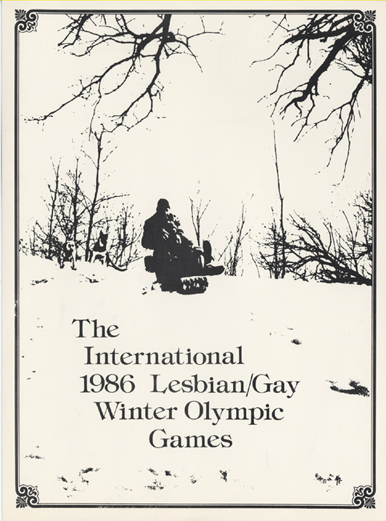Difference between revisions of "The 1986 Winter Gay Games"
(table) |
|||
| Line 4: | Line 4: | ||
| − | Sporting events are an often-overlooked aspect of queer life in the Twin Cities, partly because they challenge a popular association with sports and heterosexual masculinity. Community activists Robin Karas and Jean-Nickolaus Tretter proposed to hold the 1986 Lesbian/Gay Olympic Games in the Twin Cities. The two cited clean environmental surroundings, a vibrant local community, and “the finest facilities”<small>(1)</small> as good reasons to hold the “Winter Gay Games” in Minneapolis/St. Paul. Mayors Donald M. Fraser of Minneapolis, George Latimer of St. Paul, state Senator Allen Spear, Minnesota Representative Karen Clark, and other local politicians signed letters of support for the games. These letters are still available in a 61-page bid that details the event, complete with 21 sporting events ranging from “traditional” ice-skating to non-traditional “snow-object building.” | + | {| {{prettytable}} |
| + | ! | ||
| + | ! | ||
| + | |- | ||
| + | | Sporting events are an often-overlooked aspect of queer life in the Twin Cities, partly because they challenge a popular association with sports and heterosexual masculinity. Community activists Robin Karas and Jean-Nickolaus Tretter proposed to hold the 1986 Lesbian/Gay Olympic Games in the Twin Cities. The two cited clean environmental surroundings, a vibrant local community, and “the finest facilities”<small>(1)</small> as good reasons to hold the “Winter Gay Games” in Minneapolis/St. Paul. Mayors Donald M. Fraser of Minneapolis, George Latimer of St. Paul, state Senator Allen Spear, Minnesota Representative Karen Clark, and other local politicians signed letters of support for the games. These letters are still available in a 61-page bid that details the event, complete with 21 sporting events ranging from “traditional” ice-skating to non-traditional “snow-object building.” | ||
| − | The Minnesota Lesbian/Gay Committee of the International Gay Olympic Association (ML/GC-IGOA) located their offices in the West 7th Neighborhood Center—built in 1924 as the Riverside School. At the time of its construction, the Riverside School served an expanding suburban neighborhood that sprawled at the feet of Highland Park’s River bluffs. However, and as suburbanization advanced to the city limits, families left the neighborhood to queer populations. The former school was situated near two ice skating arenas and the Highland Park Golf Course. In fact, the Minnesota Committee of the IGOA hosted the first co-chairs conference on January 21-22,1984 at this site. | + | The Minnesota Lesbian/Gay Committee of the International Gay Olympic Association (ML/GC-IGOA) located their offices in the West 7th Neighborhood Center—built in 1924 as the Riverside School. |
| + | | [[Image:Winter Games cover.jpg]] | ||
| + | |} | ||
| + | |||
| + | |||
| + | At the time of its construction, the Riverside School served an expanding suburban neighborhood that sprawled at the feet of Highland Park’s River bluffs. However, and as suburbanization advanced to the city limits, families left the neighborhood to queer populations. The former school was situated near two ice skating arenas and the Highland Park Golf Course. In fact, the Minnesota Committee of the IGOA hosted the first co-chairs conference on January 21-22,1984 at this site. | ||
Revision as of 16:54, 26 February 2010
900 Albion Street, St. Paul
At the time of its construction, the Riverside School served an expanding suburban neighborhood that sprawled at the feet of Highland Park’s River bluffs. However, and as suburbanization advanced to the city limits, families left the neighborhood to queer populations. The former school was situated near two ice skating arenas and the Highland Park Golf Course. In fact, the Minnesota Committee of the IGOA hosted the first co-chairs conference on January 21-22,1984 at this site.
Unfortunately, financial and volunteer resources were not as readily present as organizers had hoped. The Committee awarded Twin Cities rights to host the 1986 Winter Games from the International Committee, yet these circumstances inhibited the games from taking place. Despite this, the basic organization of the formal bid remains evident in the Gay Games to this day.\
(1)Letter sent to Dr. Tom Waddell from Mayor Donald M. Fraser and George Latimer. January 12th, 1983. From “The International 1986 Gay/Lesbian Winter Olympic Games” by Jean-Nickolaus Tretter and Robin Karas. Courtesy of the Jean-Nickolaus Tretter Collection in GLBT Studies.
Part of Minneapolis/St. Paul, MN: 100 Queer Places in Minnesota History, (1860-1969), (1969-2010)
